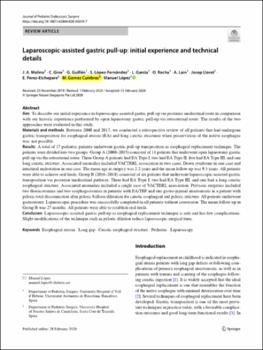Laparoscopic-assisted gastric pull-up: initial experience and technical details
Fecha
2020Resumen
Aim To describe our initial experience in laparoscopic-assisted gastric pull-up via posterior mediastinal route in comparison
with our historic experience performed by open laparotomy gastric pull-up via retrosternal route. The results of the two
approaches were evaluated in this study.
Materials and methods Between 2000 and 2017, we conducted a retrospective review of all patients that had undergone
gastric transposition for esophageal atresia (EA) and long caustic strictures when preservation of the native esophagus
was not possible.
Results A total of 17 pediatric patients underwent gastric pull-up transposition as esophageal replacement technique. The
patients were divided into two groups. Group A (2000–2015) consisted of 11 patients that underwent open laparotomy gastric
pull-up via the retrosternal route. Three Group A patients had EA Type I, two had EA Type II, fve had EA Type III, and one
long caustic stricture. Associated anomalies included VACTERL association in two cases, Down syndrome in one case and
intestinal malrotation in one case. The mean age at surgery was 2.2 years and the mean follow-up was 9.3 years. All patients
were able to achieve oral feeds. Group B (2016–2018) consisted of six patients that underwent laparoscopic-assisted gastric
transposition via posterior mediastinal pathway. Three had EA Type I, two had EA Type III, and one had a long caustic
esophageal stricture. Associated anomalies included a single case of VACTERL association. Previous surgeries included
two thoracotomies and two esophagostomies in patients with EA/TEF and one gastro-jejunal anastomosis in a patient with
pyloric total disconnection after pyloric balloon dilatation for caustic esophageal and pyloric stricture. All patients underwent
gastrostomy. Laparoscopic procedure was successfully completed in all patients without conversion. The mean follow-up in
Group B was 27 months. All patients were able to establish oral feeds.
Conclusion Laparoscopic-assisted gastric pull-up as esophageal replacement technique is safe and has few complications.
Slight modifcations of the technique such as pyloric dilation reduce laparoscopic surgical time.






